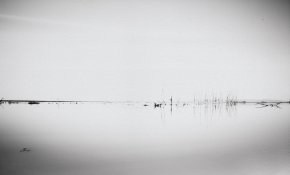Here is a salt print of a salt evaporation pond. After making the exposure, I collected water from within this scene and used it to coat the paper. The print is made from water that is in this photograph.
Details and thoughts, for interest:
Thanks to Thomas and this MSA, I discovered the
Napa Sonoma salt marshes and enjoyed exploring
several of its parts. The marsh includes about 13000 acres that were once used in salt production. The evaporative ponds were used in the 1950's by the Leslie Salt company and later by Cargill Salt works. Now most of it serves as a wildlife refuge. This particular pond is over 300 acres and was one of the final evaporation pools before processing into salt. There is a picturesque old train station nearby that I intend to visit later with my camera! Also, dogs are allowed here after the nesting season is over and my dog (and avatar )
Mango will be thrilled to help me explore many miles of trails here!
Photo Details:
I made three 8x10 paper negatives. This one was made with a fixed focus foamcore camera. The lens is a Bausch and Lomb Rapid Rectilinear from a 100 year old Kodak 3A camera. It covers 8x10 with the front lens element removed. Since the negatives were intended for salt printing, no contrast controls were used. My MSA entry is the salt print above, but I would like to show you the negative too because it looks neat. Here's the camera and the negative ( click to see the negative large... it looks cool! ):


Not MSA entries, but here's another made a with a pinhole camera, inverted scan of the negative. You can see Mt. Tamalpais on the horizon.


And finally one with a sliding box foamcore camera, also a negative scan:


This sliding box camera is capable of making the best negatives, but I didn't trust myself to get it right for the main picture, so I used the fixed focus I have more confidence with.
Salt Print Details:
I'd read that salinity of these ponds ranges from about 2.5% ( same as SF bay ) up to hyper-salinity levels. Right now at the end of our rainy season, the pond is full,so it should be on the low end, but as I was hiking to the pond I saw fish and tadpoles in a creek that empties into it, and when I collected the water I saw green algae growing and insects swimming underwater. That made me think the water might not be very salty! So I decided to try my first salt print using it undiluted,and also had (there was a url link here which no longer exists) figuring out that it probably is a bit less than 2%. So as luck would have it, my print came out nice on the first try!
I brought 500ml of water home, boiled it in a mason jar in my microwave then filtered it twice. After that I added 1.5g of citric acid, to hopefully help prevent fogging.
Canson Universal Sketch paper, cut to 7x11 inches. Floated for 3 minutes on this solution, then dried overnight. Then I brushed on 1ml of 12% silver nitrate, 6% citric acid solution, and let it dry in the dark for 3 hours.
Exposure in the contact frame: 2.5 late afternoon hours aimed at North open sky. I was planning on ½ hour direct sun, but a cloud covered the sun so it was 20 minutes aimed at that cloud. Then the sun came back out at 5PM and I let it go another 30 minutes directly aimed at the sun.
Wash 2 x 5 minutes in water with a pinch of salt, then 2 x 4 minutes in hypo: ½ teaspoon per 4oz water. Quick rinse then 3 minutes in 1% sodium sulfate. Washed in frequent changes of water for an hour. Then dried overnight flat on a piece of glass.
I had a lot of fun doing all of this and learning something new about the area I live in.















